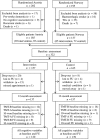Multidomain intervention for the prevention of cognitive decline after stroke - a pooled patient-level data analysis
- PMID: 29782693
- PMCID: PMC6099341
- DOI: 10.1111/ene.13684
Multidomain intervention for the prevention of cognitive decline after stroke - a pooled patient-level data analysis
Abstract
Background and purpose: The aim of this pooled patient-level data analysis was to test if multidomain interventions, addressing several modifiable vascular risk factors simultaneously, are more effective than usual post-stroke care for the prevention of cognitive decline after stroke.
Methods: This pooled patient-level data analysis included two randomized controlled trials using a multidomain approach to target vascular risk factors in stroke patients and cognition as primary outcome. Changes from baseline to 12 months in the trail making test (TMT)-A, TMT-B and 10-words test were analysed using stepwise backward linear mixed models with study as random factor. Two analyses were based on the intention-to-treat (ITT) principle using different imputation approaches and one was based on complete cases.
Results: Data from 322 patients (157 assigned to multidomain intervention and 165 to standard care) were analysed. Differences between randomization groups for TMT-A scores were found in one ITT model (P = 0.014) and approached significance in the second ITT model (P = 0.087) and for complete cases (P = 0.091). No significant intervention effects were found for any of the other cognitive variables.
Conclusion: We found indications that multidomain interventions compared with standard care can improve the scores in TMT-A at 1 year after stroke but not those for TMT-B or the 10-words test. These results have to be interpreted with caution due to the small number of patients.
Keywords: cognition; cognitive decline; lifestyle; multidomain intervention; pooled data analysis; post-stroke dementia; prevention; stroke.
© 2018 The Authors. European Journal of Neurology published by John Wiley & Sons Ltd on behalf of European Academy of Neurology.
Figures
References
-
- Pendlebury ST, Rothwell PM. Prevalence, incidence, and factors associated with pre‐stroke and post‐stroke dementia: a systematic review and meta‐analysis. Lancet Neurol 2009; 8: 1006–1018. - PubMed
-
- Hurford R, Charidimou A, Fox Z, Cipolotti L, Werring DJ. Domain‐specific trends in cognitive impairment after acute ischaemic stroke. J Neurol 2013; 260: 237–241. - PubMed
-
- Leśniak M, Bak T, Czepiel W, Seniów J, Członkowska A. Frequency and prognostic value of cognitive disorders in stroke patients. Dement Geriatr Cogn Disord 2008; 26: 356–363. - PubMed
-
- Ballard C, Rowan E, Stephens S, Kalaria R, Kenny RA. Prospective follow‐up study between 3 and 15 months after stroke: improvements and decline in cognitive function among dementia‐free stroke survivors >75 years of age. Stroke 2003; 34: 2440–2444. - PubMed
Publication types
MeSH terms
LinkOut - more resources
Full Text Sources
Other Literature Sources
Medical


